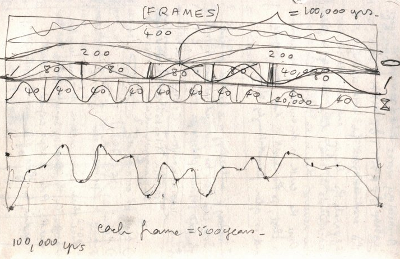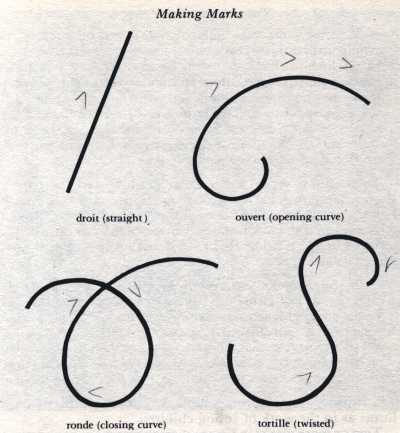|
Trace forms
[2008-05-31]
animation: Lisa Roberts
London 2008
Story: Dominic Hodgson
British Antarctic Survey, Cambridge, April 2008
Rhythmic patterns of motion
reflect the Milankovitch cycles:
eccentric orbit of Earth around sun (100 frames);
oblique tilt of Earth on its axis (40 frames)
and precessional wobble around it. (20 frames).

This drawing was made
with expeditioner, Ken Wilson,
to work out how the Milankovitch cycles
may be described in animation
as a rhythmic pattern.
Trace forms are pathways
bodies describe
moving through space and time.
Human trace forms are defined
by our body's internal structures.
Like scientists exploring
an unknown landscape,
Improvisers draw with their bodies
as if for the very first time.
Earth motions are governed
by gravitational forces
defined by celestial architecture.
Structure's unknown to the naked eye
define intricate trace form patterns.
The rhythmic patterns of this animation
reflect the Milankovitch cycles:
eccentric orbit of Earth around sun (100 frames);
oblique tilt of Earth on its axis (40 frames)
and precessional wobble around it. (20 frames).
The swinging arcs suggest curving trace forms
of Earth moving through these cycles.
Swinging a child in a hammock
is a metaphor used by del Valle
to describe the natural cycles
that mankind is interrupting.
We do not know what will happen
as our hammock swings out of control.

The tradition of the dance enumerates
four fundamental trace forms
which have the following shapes,
called in the terminology of classical ballet
'droit' (straight),
'ouvert' (curved),
'tortille' (twisted),
and 'ronde' (rounded).
They are standard forms
which occur in all
human movements...
and they may evolve in space
in one or several zones of the limbs.
Laban (1966)
cited by Elisabeth Watts,
Towards Dance and Art 1977 p.13-14
| 